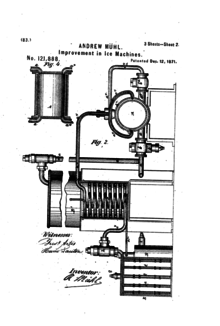Several approaches existed for ice manufacturing during the early days. Mechanical refrigeration often referred to simply as refrigeration is a process by which heat is removed from a location using a man-made heat-exchange system.
First an electric motor replaced the gas motor.
History of mechanical refrigeration. The basis of mechanical refrigeration is the fact that at different pressures the saturation or the condensing temperatures of vapors are different as clearly shown on the appropriate vapor-pressuretemperature curve. The first practical machine was built by Jacob Perkins in 1834. The first instance of using mechanical refrigeration however was not until 1755.
Patent for mechanical refrigeration was issued in 1851 to a Florida doctor who developed an air-cycle system to build ice which was then used to cool a yellow fever ward. In 1820 Michael Faraday a Londoner first liquefied ammonia to cause cooling. Patent for mechanical refrigeration in 1851 after giving up his medical practice to focus on his experimentation with ice making.
The early refrigeration systems designed between 1850 and 1920 produced ice year-round to compete with harvested ice. Principles of Mechanical Refrigeration 1964 - CharlieDeanArchives. During the 1800s many mechanical-type refrigeration systems were being invented and used refrigerants such as sulphur dioxide methyl chloride ether carbon dioxide as well as wine brandy vinegar etc.
The system of refrigeration can be cyclic non-cyclic thermoelectric or magnetic depending on the application for which refrigeration is needed. Ferdinand Carre of France developed the first ammoniawater refrigeration machine in 1859. This system used a compressor to force the refrigeration gas to pass through a condenser where it cooled down and liquefied.
Covered ice-skating rink Chelsea England. Until 1851 Evans obtained the first patent for mechanical refrigeration in the USA. First intercontinental refrigerated transport by ship UK 1876.
The technique of evaporative cooling as described heretofore has been known for centuries but the fundamental methods of mechanical refrigeration were only discovered in the middle of the 19th century. The early refrigeration systems de-signed between 1850 and 1920 produced November 2004 ice year-round to compete with harvested ice. By 1900 the meat packing houses of Chicago had adopted ammonia-cycle commercial refrigeration.
Mechanical refrigeration was subsequently introduced to make the ice and it would be transported to where the cooling effect was required. As the pressure increases condensing temperatures also increase. James Harrison was a Scottish-Australian newspaper printer journalist politician and pioneer in the field of mechanical refrigeration.
Scottish professor William Cullen drafted a machine that used a pump to create a vacuum in a container of diethyl ether. The History of Refrigerant Mechanical refrigeration has been around since the mid-nineteenth century. In 1859 Ferdinand Carre from France invented the first version of the ammonia water cooling machine.
In 1911 General Electric introduced the first home refrigerator. Carbon Dioxide CO2 was first used as a refrigerant in 1866 and Ammonia NH3 in 1873. In 1820 Michael Faraday a Londoner first liquefied ammonia to cause cooling.
Needless to say humans have long recognized the importance and the power of refrigeration. Cold storage plant using mechanical refrigeration by Thomas Mort of Australia. Principles of Mechanical Refrigeration 1964 - CharlieDeanArchives - YouTube.
The first known artificial refrigeration was demonstrated by William Cullen at the University of Glasgow in 1748. The Invention of Mechanical Refrigeration. Refrigerant is said to have undergone a closed refrigeration cycle.
The refrigeration energy available in this way is mainly its latent heat of melting 334 kJkg as it changes back to water. It was based on using ether as a refrigerant in a vapour compression circuit. Sutherland of Detroit Michigan patented the refrigerator car designed with ice tanks at either end of the car and ventilator flaps near the floor which would create a gravity draft of cold air through the car.
Sulfur Dioxide refrigerant successfully used as a refrigerant by Raoul Pictet in Switzerland. The harvested ice producers advertised that-when it was available-their natural refrigeration did not fail like the early mechanical systems. These mechanical refrigerators caught on and revolutionized commercial food storage and shipping throughout the remainder of the 19th century.
He was granted the first US. We may take the refrigerator for granted but when you look back at its history youll see. His first commercial ice-making machine was made in 1854.
By 1930 two major changes made consumer refrigerators highly practical.
